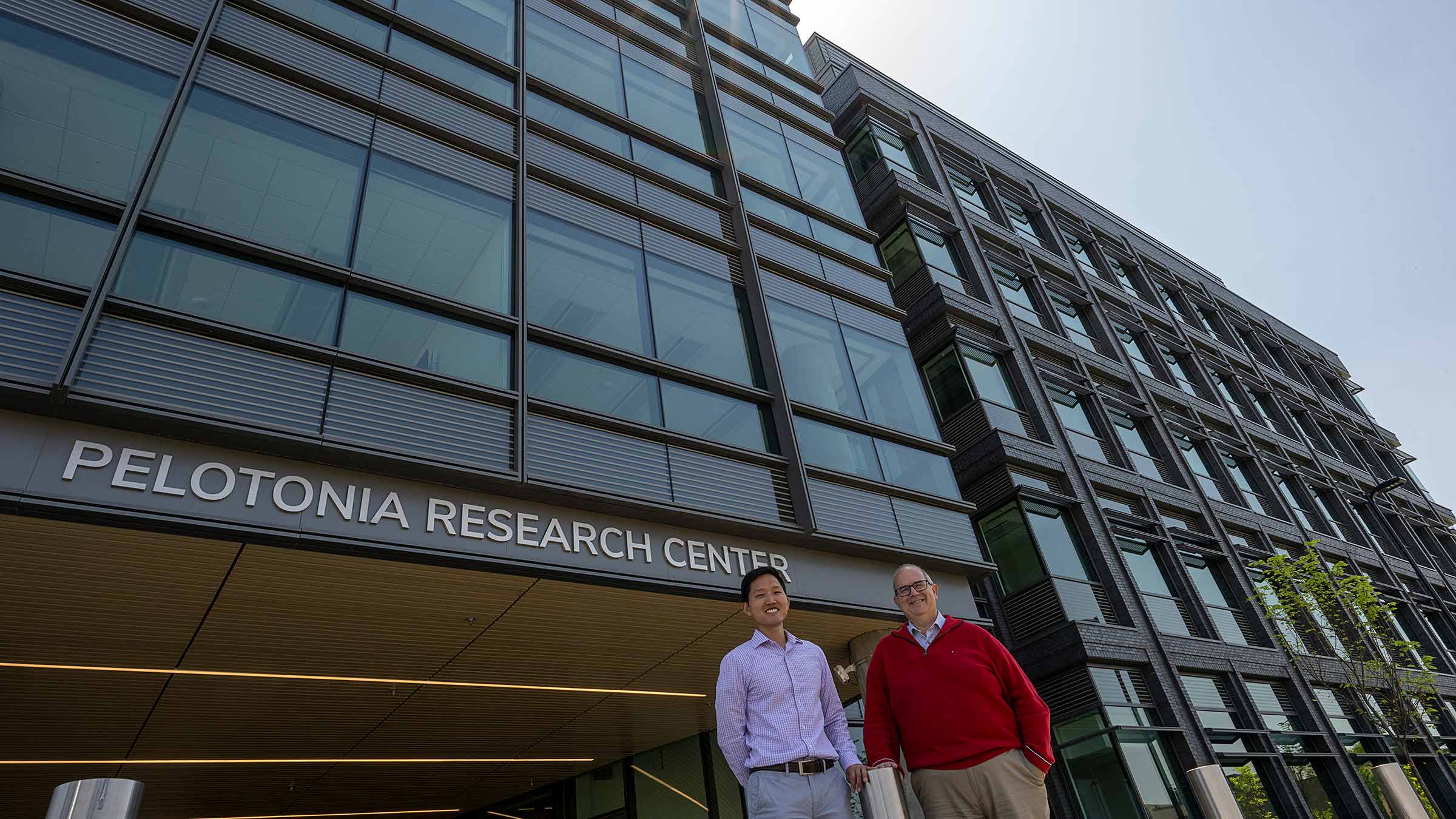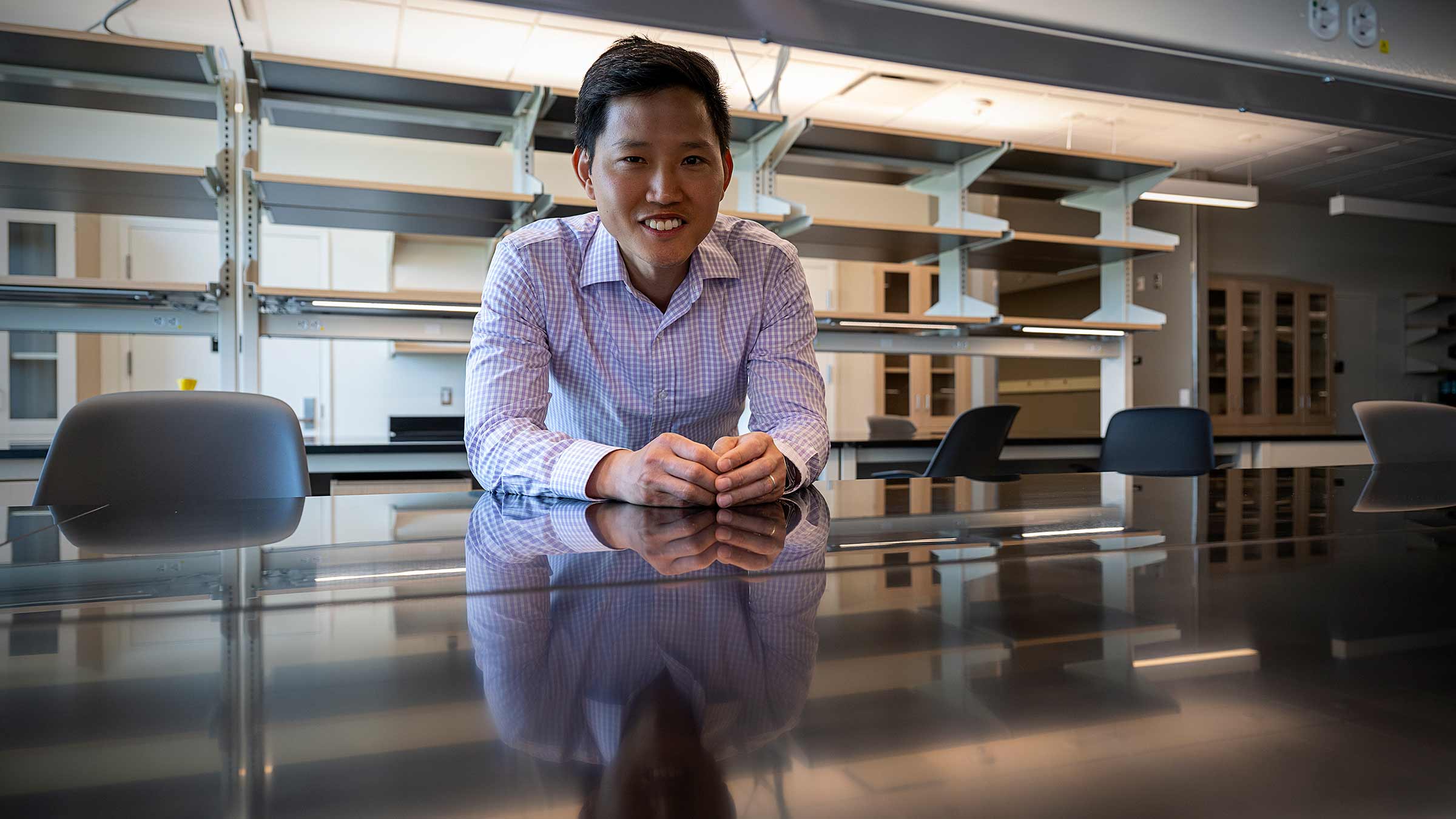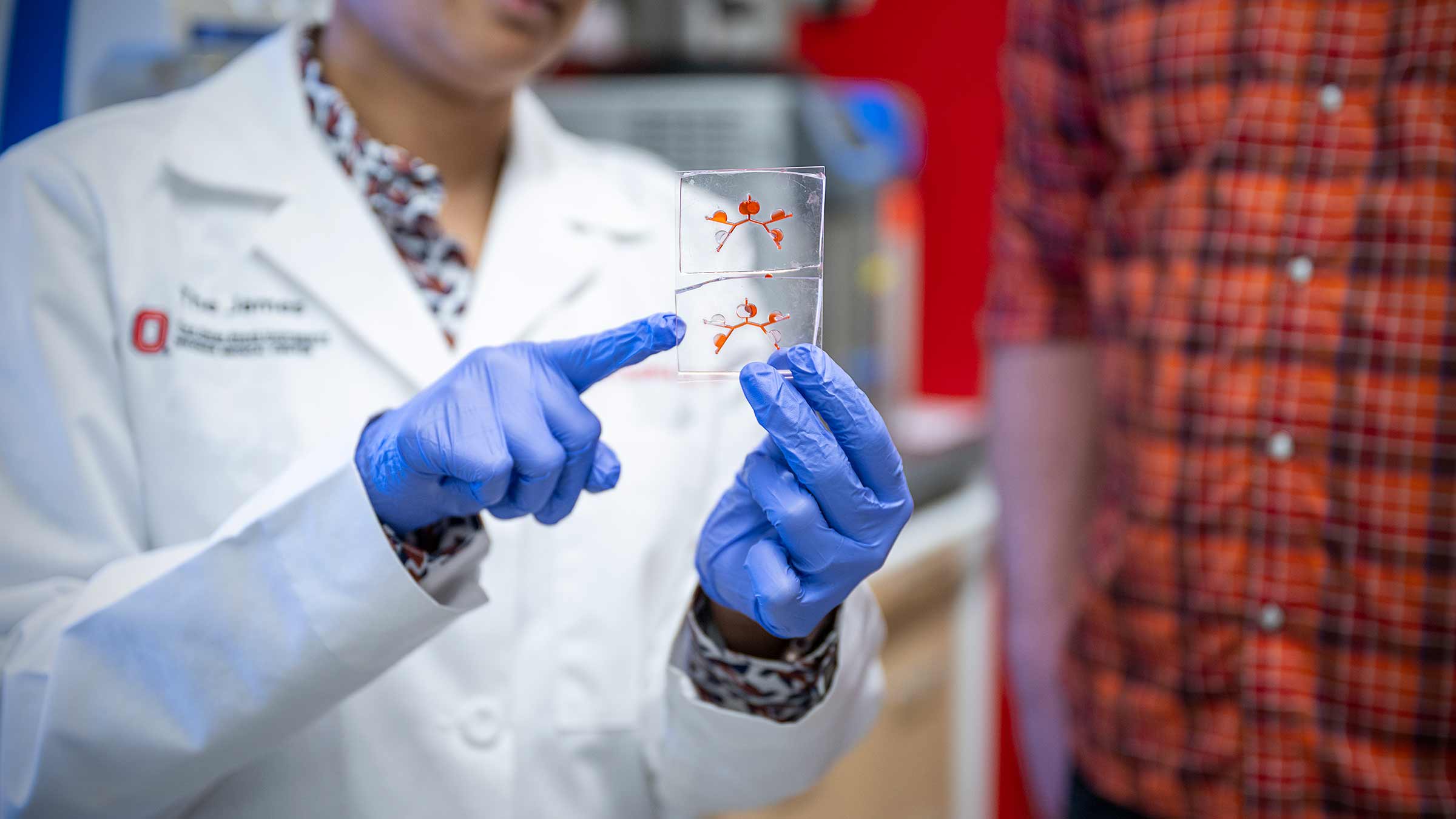Engineering unimaginable approaches to cancer treatment
The Center for Cancer Engineering at Ohio State is combining the talents of engineers, scientists and cancer researchers to tackle uncharted cancer treatment advances.
Partnerships between engineers and cancer researchers may seem unlikely to some, but at The Ohio State University such pairings are plentiful — and paying off for patients.
Consider, for example, how researchers in several colleges at the university are teaming up to apply nanotechnology — which involves working at the scale of a nanometer (a billionth of a meter) — to improve the detection and treatment of cancer. Through nanotechnology, scientists are making materials and devices for detecting, diagnosing and even treating cancer by delivering therapeutic genetic material into tumor cells with minimal side effects.
The Ohio State University Comprehensive Cancer Center – Arthur G. James Cancer Hospital and Richard J. Solove Research Institute (OSUCCC – James) and Ohio State’s College of Engineering have found so much promise in the merger of minds that they have created a special center to support it, paving the way for treatment innovations that previously were unimaginable.
The OSUCCC – James Center for Cancer Engineering – Curing Cancer through Research in Engineering and Sciences (CCE-CURES) is a multidisciplinary collaboration to develop and integrate engineering technologies and data science with cancer biology to enhance cancer prevention, diagnosis and treatment.
Headquartered on the second floor of the new Pelotonia Research Center, the CCE-CURES program pursues fascinating approaches to combating cancer.
“We can identify clinical solutions in cancer for which engineering solutions are highly relevant,” says OSUCCC Director Raphael E. Pollock, MD, PhD, FACS.
Dr. Pollock cites several examples, such as using Ohio State’s sophisticated electron microscopy unit to analyze the makeup of frozen sample cells and other molecular structures relevant to cancer. This technique, called cryo-electron microscopy (cryo-EM), is applied to samples that have been cooled to extremely low temperatures and embedded in a thin layer of vitreous water. By overcoming challenges associated with traditional electron microscopy, cryo-EM enables scientists to see how biomolecules move and interact as they perform their functions.
Other engineering applications to cancer research and care, Dr. Pollock says, include a nanotechnology delivery system for topical application of drugs, liquid biopsy, molecular imaging and 3D modeling of patient anatomy (tissue, tumors, bone structure). “These are just a few of the many applications that fall under the broad rubric of cancer engineering,” he adds.
“The central concept of cancer engineering is to take the technologies, methods and tools that engineers, physical and material scientists possess and apply them to cancer research to improve the care of our patients,” says CCE-CURES Co-Director Matthew Ringel, MD, a thyroid cancer specialist who also serves as professor and chair of the Department of Molecular Medicine and Therapeutics in The Ohio State University College of Medicine, where he holds the Ralph W. Kurtz Chair in Hormonology. “We have a wonderful spirit of teamwork among the many disciplines at the university that are involved in this effort.”
CCE-CURES Co-Director Jonathan Song, PhD, an associate professor in the College of Engineering’s Department of Mechanical and Aerospace Engineering, says the program pools the expertise of some 60 scientists from seven of the university’s 15 colleges, including: Engineering; Medicine; Arts and Sciences; Pharmacy; Veterinary Medicine; Food, Agricultural and Environmental Sciences; and Public Health.
And these efforts will keep expanding. Dr. Song notes that the program “supports the recruitment of five to seven new faculty to Ohio State over the next two to four years with our partnering colleges.”

Engineering enhances the arsenal
Drs. Ringel and Song, both of whom are also researchers at the OSUCCC – James, believe the engineering skills and technology that CCE-CURES scientists provide are enabling clinicians to better understand how cancer grows and spreads, as well as how to stop it.
“A growing tumor is really an engineering system,” Dr. Song says. “As a tumor evolves, its physical and mechanical properties change, and these changes are key drivers of cancer progression and metastasis (spread). Using engineering skill sets and quantitative analysis, we’re getting a clearer understanding of tumor biology and how engineering technologies can be also applied to advance cancer therapy.”
The CCE-CURES program has three primary focus areas:
- Imaging and Detection — Using advanced microscopy, including cryo-EM, scientists are developing methods to better analyze molecular structure and function, design drugs and devise ways to confirm biological functions and cellular interactions so they can understand the mechanics of cancer and find ways to treat it.
- Machine Learning/Artificial Intelligence — Scientists are developing machine learning and algorithms (calculation processes) to analyze data from multiple levels of biology and apply it to the modeling of patient anatomy to plan and guide surgery.
- Tissue Engineering, Biomaterials, Biomechanics and Drug Delivery — Scientists are developing cell culture scaffolds and technologies; using biofabrication (creating biologic products from cells and molecules) to make anatomic models of organs and tumors; and developing nanostructures or nanomaterials to facilitate drug delivery within the body.
CCE-CURES occupants in the Pelotonia Research Center
At its second-floor home in the new Pelotonia Research Center, the CCE-CURES program will house groups of scientists focused on two important approaches to overcoming barriers that have impeded new cancer diagnostics and therapies:
- the development of reproducible models of cancer that more closely mimic the complexity of human cancer progression to identify new treatment targets and enable more rapid development of new drugs
- the development of new systems to detect and treat cancer using nanotechnologies
Drs. Ringel and Song say the second floor will include faculty from multiple colleges and will include investigators who are experts at making scientific discoveries and technological advances, and then linking them to human cancer data, including:
Daniel Conway, PhD, of Biomedical Engineering, who uses advanced microscopy for understanding the biological drivers of cancer metastasis; Priya Dedhia, MD, PhD, of Surgical Oncology, Lawrence Kirschner, MD, PhD, of Endocrinology, Aleksander Skardal, PhD, of Biomedical Engineering, and Drs. Ringel and Song, all of whom work on experimental platforms to better model cancer progression and use these systems to discover cancer drugs and interventions. These groups collaborate with Dr. Conway for imaging, and with other experts on campus who are part of CCE-CURES.
Multiple CCE-CURES faculty in the Pelotonia Research Center will be engaged in the development and production of nanotherapeutics. Researchers in this area include Xiaoguang (Margaret) Liu, PhD, of Chemical and Biomolecular Engineering; Jessica Winter, PhD, of Chemical and Biomolecular Engineering and Biomedical Engineering; and Carlos Castro, PhD, of Mechanical and Aerospace Engineering.
Drs. Ringel and Song say collaborations among these researchers are underway, and new cancer research faculty already are being recruited into each of the research areas housed in the Pelotonia Research Center. One example is newly recruited faculty member Blaise Kimmel, PhD, of Chemical and Biomolecular Engineering, whose research combines synthetic biology with cancer immunology.

Innovative engineering labs
Two prime examples of highly targeted laboratory applications that are supported by the CCE-CURES program and other entities at Ohio State are the Skardal Biofabrication Lab led by Dr. Skardal, and the Medical Modeling, Materials and Manufacturing (M4) Lab led by Kyle VanKoevering, MD, of the College of Medicine, Department of Otolaryngology – Head and Neck Surgery.
Combining engineering techniques and cancer research, the Biofabrication Lab builds tiny lifelike organs and tumors from a patient’s own cells to test how the patient may respond to drug and immunotherapy treatments.
The M4 Lab supports medical professionals and other faculty via bioengineering, medical-device development, and clinical 3D printing of patient-tailored anatomic models that can be used in the operating room as guides for removing tumors and reconstructing anatomy at the removal site.

Synergies between engineering and cancer treatment
Drs. Ringel and Song say the overarching goal of the CCE-CURES program is to traverse barriers to new cancer therapies so researchers can more rapidly find treatment targets, develop optimal therapies for individual patients and improve outcomes.
“We’re motivated by the central challenge of what we can do to accelerate the pace of breakthroughs in preventing, diagnosing and treating cancer,” Dr. Ringel says, pointing out that engineering and physical science principles and technologies have already helped transform many aspects of medical care via such innovations as MRI scans, systems that allow blood tests to be performed more quickly and accurately, and new methods to more effectively diagnose cancer.

“We believe the connection between the engineering and scientific disciplines and cancer research and care can rapidly move the needle to improve the health of all people,” Dr. Ringel says.
Dr. Song views CCE-CURES as another strong component of Ohio State’s acclaimed cancer program.
“Ohio State is one of only a few places in the country that have a top-tier cancer center along with top-ranked colleges and departments in engineering and physical sciences on one campus with thousands of students,” he says. “The enthusiastic collaboration that is prevalent among these areas, along with the unwavering support of our leaders, fosters an environment for transformative discoveries and sets the stage for the university to be a world leader in cancer research and care for generations.”
“We’ve already had cancer investigators across campus working with people in engineering, chemistry and other physical sciences,” Dr. Ringel says, “but by having a dedicated center that supports that work, we can now do it in a more methodized and targeted manner than most other institutions. We really want to extend the science so that, in just a few years, we’ll have innovations that we can’t even imagine today.”

Your support fuels our vision to create a cancer-free world
Your support of cancer care and pioneering research at Ohio State can make a difference in the lives of today’s patients while supporting our work to improve treatment and reduce cases tomorrow.
Ways to Give




